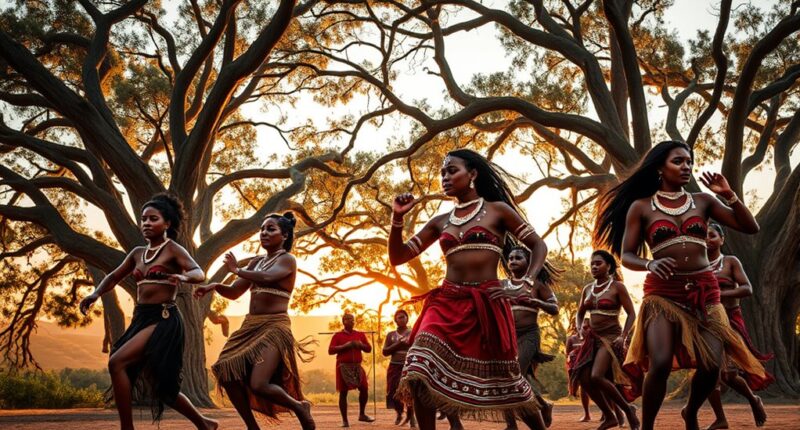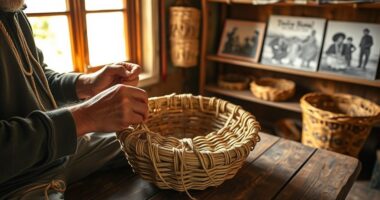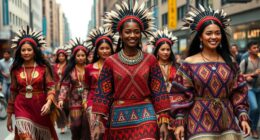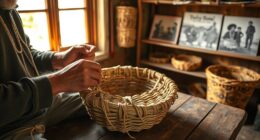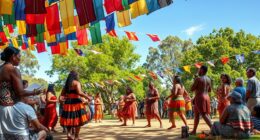Australian Indigenous dance styles range from traditional corroborees to modern performances that blend rituals with contemporary art. These dances celebrate land, ancestors, and stories through expressive movements, costumes, and rhythms. Corroborees are sacred ceremonies with intricate gestures, while contemporary dance often mixes traditional elements with new media and styles. By exploring these diverse forms, you’ll gain insight into a vibrant cultural heritage that continues to evolve and thrive across Australia.
Key Takeaways
- Indigenous dance styles vary across regions, with Corroboree being the most well-known, depicting stories of creation and ancestral journeys.
- Traditional dances involve ceremonial costumes, body paint, and rhythmic music, emphasizing spiritual and cultural significance.
- Modern adaptations incorporate contemporary music, multimedia, and choreography, blending traditional elements with new artistic expressions.
- Dance serves as a living archive, preserving history, reinforcing community bonds, and expressing identity across diverse Indigenous groups.
- Performances are both sacred ceremonies and public displays, highlighting the resilience and evolving nature of Indigenous cultural expression.
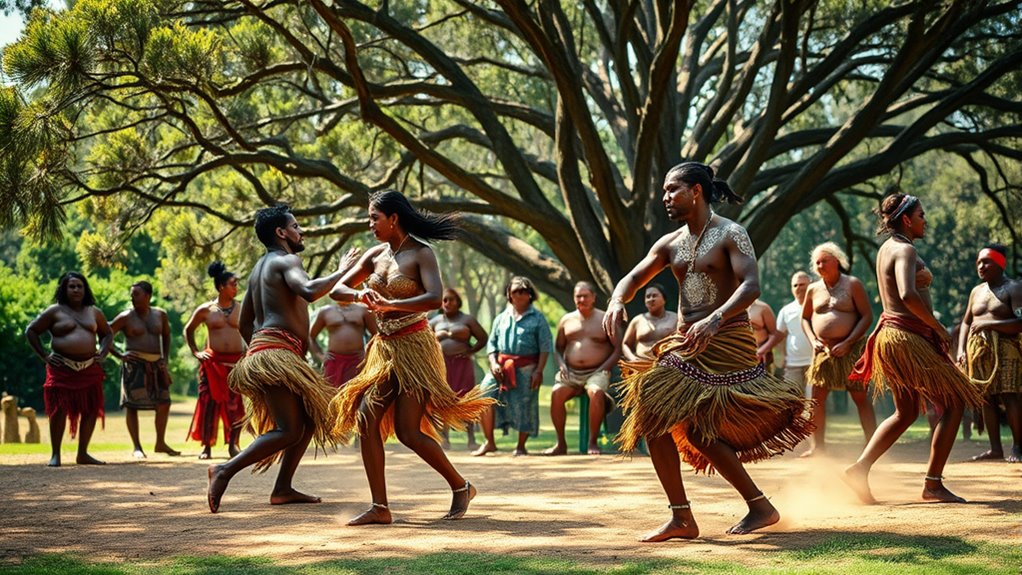
Australia’s Indigenous communities have rich dance traditions that serve as essential expressions of their culture, stories, and spiritual beliefs. When you observe these dances, you’re witnessing more than movement—you’re experiencing a deep connection to the land, ancestors, and the stories that have been passed down through generations. These dances hold immense cultural significance, acting as living archives that preserve history, teach lessons, and reinforce community bonds. Each movement, rhythm, and gesture carries meaning, often representing elements of nature, ancestral beings, or important events. As you explore these dances, you’ll notice how they serve as artistic expressions that communicate complex ideas without words, conveying identity and tradition through visually compelling performances.
In Indigenous communities, dance isn’t just entertainment; it’s a crucial part of ceremonies, storytelling, and cultural preservation. The corroboree, perhaps the most well-known Australian Indigenous dance, exemplifies this. During corroborees, dancers wear traditional body paint, adornments, and costumes that reflect their specific cultural heritage. The rhythmic beating of drums and clapping accompany their movements, creating a vibrant, immersive experience. These dances often depict stories of creation, ancestral journeys, or natural phenomena, making each performance a sacred act that reinforces spiritual beliefs. By participating in or observing these dances, you gain insight into the community’s worldview, values, and history, as well as their ongoing relationship with the land and spirits.
Artistic expressions in Indigenous dance extend beyond the movements themselves. The choreography, costumes, and musical accompaniments are all carefully crafted to convey meaning and evoke emotion. Dancers often mimic animals, natural elements, or mythological figures, transforming their bodies into living symbols. This artistry isn’t static; it evolves as communities adapt their dances to contemporary contexts, blending traditional forms with new influences. Modern Indigenous dance incorporates contemporary music, multimedia elements, and innovative choreography, allowing communities to share their stories with broader audiences and maintain cultural relevance. For you, witnessing these performances offers a powerful glimpse into how Indigenous Australians honor their past while embracing the future, ensuring their cultural expressions continue to thrive and inspire.
As you explore Australia’s Indigenous dance traditions, remember that each movement is a crucial thread in the rich tapestry of their culture. These dances serve as a bridge between generations, keeping stories alive and fostering cultural pride. They are dynamic, meaningful artistic expressions that reflect centuries of history, spirituality, and connection to the land. Whether performed at sacred ceremonies or on contemporary stages, Indigenous dance remains a profound testament to resilience, identity, and the enduring spirit of Australia’s First Peoples.
Frequently Asked Questions
How Do Indigenous Dances Vary Across Different Regions?
You’ll notice that indigenous dances vary across regions due to different cultural traditions and environments. These regional variations influence dance symbolism, reflecting each community’s unique stories, beliefs, and connection to land. For example, coastal dances might emphasize water spirits, while desert dances focus on land and ancestors. These differences help preserve cultural identity and pass down important stories, making each dance style distinct and meaningful within its regional context.
What Materials Are Traditionally Used in Indigenous Dance Costumes?
Your costume craftsmanship is like a woven tapestry of tradition, using natural materials that tell stories. You’ll find traditional materials such as bark, feathers, shells, ochre, and plant fibers crafted into intricate costumes. These elements help you connect deeply to your culture and environment. Every piece is carefully chosen and assembled, creating costumes that are both meaningful and vibrant, embodying the spirit of your ancestors and the stories you perform through dance.
How Has Contemporary Dance Influenced Traditional Indigenous Styles?
Contemporary dance influences traditional Indigenous styles through fusion choreography and modern adaptations, blending cultural stories with new movement techniques. You might see traditional symbols incorporated into contemporary forms, creating a dynamic dialogue between past and present. This integration allows Indigenous dancers to express their identity creatively while honoring their heritage. As a result, traditional dance evolves, gaining fresh perspectives and reaching wider audiences, all while maintaining cultural significance.
Are There Specific Dances for Ceremonies Versus Social Gatherings?
Yes, you’ll notice specific dances for ceremonies versus social gatherings. Ceremonial dances often feature rich dance symbolism and are performed in ceremonial attire, emphasizing cultural stories and spiritual beliefs. Social dances are more relaxed, focusing on community bonding. You’ll see distinct movements and costumes, reflecting the purpose of each event. These differences highlight the cultural significance and traditional roles of dance in Indigenous Australian communities.
How Do Indigenous Dances Transmit Stories and Cultural Knowledge?
You see, indigenous dances transmit stories and cultural knowledge through powerful symbolism in dance and intergenerational storytelling. When you participate or watch, you experience symbols representing Dreamtime stories, ancestral connections, and natural elements. These dances are more than movement; they’re living narratives passed down through generations, keeping the culture alive. By learning and sharing these dances, you help preserve the rich history and spiritual beliefs of Indigenous communities.
Conclusion
As you explore Australia’s indigenous dance, you witness the timeless connection to land and culture, contrasting with modern performances that push boundaries. While corroborees echo ancient stories beneath starlit skies, contemporary styles fuse tradition with innovation on vibrant stages. This juxtaposition reminds you that, whether rooted in history or embracing change, indigenous dance continues to celebrate identity, resilience, and creativity—an enduring bridge linking past and present in Australia’s rich cultural tapestry.
Mary is a passionate writer who brings creativity and a fresh perspective to our team. Her words have the power to captivate and inspire, making her an essential contributor to our content. Mary’s commitment to storytelling and dedication to promoting Indigenous culture ensures that her work touches the hearts of our readers. We’re fortunate to have her as part of our team.
